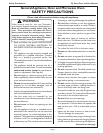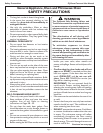
CJ Oven Care and Use Manual
Home Canning / Drying / Small Quantities
of Foods
• Do not use microwave oven for home canning.
It cannot maintain the food at a safe temperature.
Improperly canned food may spoil and be
dangerous to eat.
• Do not dry meats, herbs, fruits or vegetables.
Small quantities or foods with low moisture
content can dry out, scorch or catch on fire if
overheated.
Deep Fat Frying
• Do not deep fat fry because the oil may ignite
into flames and cause damage to the oven or
burns.
• Microwave-safe utensils may not withstand the
high temperatures of hot oil; they could shatter
or melt.
Popcorn
• Microwave popcorn that pops in its own package
can scorch or burn if placed directly on the
metal rack. Use a microwave safe utensil to hold
bag.
• Follow the directions on the bag which are
suitable for the microwave wattage of your
oven (750 W). Popping times may vary.
• Never leave oven unattended when popping
popcorn.
• Allow bag to cool before opening; always open
away from your face and body to prevent steam
burns.
Foods with Nonporous Skins
• Potatoes, apples, whole eggs, egg yolks, whole
squash and sausages are examples of foods with
nonporous skins. They must be pierced before
cooking to prevent bursting.
Liquids
• Heated liquids can erupt if not mixed with air.
Overheated liquids become superheated and
may erupt. Stir liquids before and after heating
to avoid eruption.
Cooking Utensils
• Utensils get hot during cooking. Use potholders
when removing the cookware, lids and plastic
wrap to avoid burns.
• Do not heat foods in narrow necked bottles or
sealed containers, i.e. closed glass jars. They
may explode.
Microwave Safety Precautions
Safety Precautions
MICROWAVE MODE SAFETY
• Do not tamper with, adjust or repair the door,
safety interlock switches or any other part of
the oven. Repairs must be done by a qualified
service technician.
• Do not operate the microwave mode when the
oven is empty. If food or water is not present to
absorb the energy, the oven could be damaged
with a risk of fire.
• Do not dry clothes, newspapers or other
materials in the oven. Newspapers and paper
bags are not suitable for cooking; a fire may
result.
• Do not use recycled paper products unless it is
labeled safe for microwave use. These products
may contain impurities that may cause sparks
and result in a fire.
• Dishes with metallic trim should not be used as
arcing may occur.
• When food is heated in a metal container, allow
at least 1-inch (2.5 cm) spacing from the oven
walls. Do not allow metal pans to touch each
other or arcing may occur.
Paper Towels / Cloths
• Do not use paper towels or cloths that contain
a synthetic fiber woven into them. The fiber may
cause the towel to ignite.
• Use paper towels under supervision.
Oven Cooking Bags
• Do not use the wire twist-tie to close bag. Use
plastic ties, cotton string or a strip of plastic cut
from the open end of the bag.
Baby Formula / Food
• Do not heat baby food in glass jars. Transfer the
food to a small dish and gently heat. Stir well and
check temperature before serving.
• Heating formula in bottles is not recommended,
If done, put nipple on bottle after gently heating.
Shake thoroughly to obtain uniform temperature.
Wrist test before feeding.
Ready-to-Eat Pastry products
• When reheating, check temperatures of any
fillings before eating. The fillings of some foods
heat faster than the surface, i.e. jelly donuts. The
filling can be extremely hot.
Page 5


















